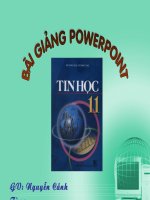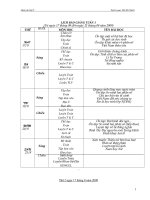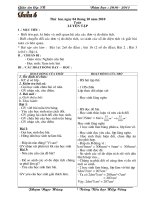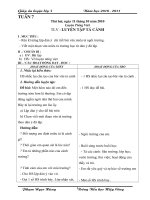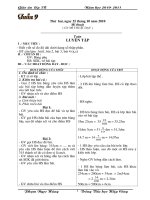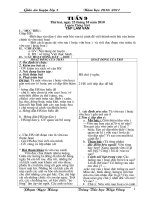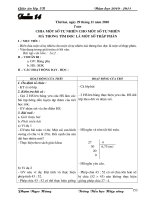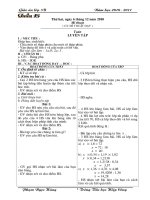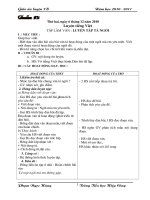- Trang chủ >>
- Mầm non - Tiểu học >>
- Lớp 5
5 3 5 very special effects computers in filmmaking TG
Bạn đang xem bản rút gọn của tài liệu. Xem và tải ngay bản đầy đủ của tài liệu tại đây (120.78 KB, 4 trang )
Very Special Effects:
Computers in Filmmaking
SUMMARY
Movies made today include many
computerized special effects to create
characters and scenes. In addition, a growing
number of movies are being shot entirely with
computers, creating benefits for moviegoers,
but complex issues for theaters.
LESSON VOCABULARY
background
miniature
reassembled
landscape
prehistoric
INTRODUCE THE BOOK
INTRODUCE THE TITLE AND AUTHOR
Discuss
with students the title and the author of Very
Special Effects: Computers in Filmmaking. Ask
students what they can tell about the book
based on the cover illustration.
BUILD BACKGROUND Ask students to discuss
films they’ve seen recently that have used
computerized special effects. Ask: How did
you know that parts of those films were made
using computers? Students might mention A
Bug’s Life, The Incredibles, Finding Nemo, or
Toy Story. Ask: Why do you like special
effects?
PREVIEW/USE TEXT FEATURES
Have students
preview the text by looking at photos,
captions, the chart on pages 20–21, and the
subheads throughout. Remind students that
text features can help organize their reading.
5.3.5
GRAPHIC SOURCES
PRIOR KNOWLEDGE
READ THE BOOK
SET PURPOSE
Have students set a purpose
for reading Very Special Effects: Computers
in Filmmaking. Some students may be
curious about how computerized characters
are created. Others may have an interest in
becoming computer animators or in using
home digital video cameras to make their own
movies.
STRATEGY SUPPORT: PRIOR KNOWLEDGE
Encourage students to use their own prior
knowledge to expand upon the graphic source
on pages 20–21. For instance, ask students
what impact computerized filmmaking might
have on the popularity of old movie classics,
such as The Wizard of Oz. Encourage students
to think of other pros and cons to add to the
diagram, based on their own experiences.
COMPREHENSION QUESTIONS
PAGES 4–5
How has computerized filmmaking
helped directors? (They can create vibrant sets
on a computer rather than on a big stage; they
can cover up background objects or add objects.)
PAGE 6 What did early special effects use?
(hand-drawn animation, clay models or puppets)
PAGE 11
How does the graphic source on
page 11 help explain rotoscoping? (It shows
how the frames of film are outlined and then
blanked out.)
PAGE 14
What happens during compositing?
(Layers of computer graphic work are placed
one atop the next; then the digital file is turned
to film.)
PAGE 19
How are computer-based digital
movies edited? (Computer code can simply be
rearranged—like cutting and pasting text.)
PAGE 23
Why is the movie industry worried
about computerized movies? (Since digital
movies can be downloaded, moviegoers might
go to theaters less.)
68
Very Special Effects: Computers in Filmmaking
16917_LRD_TG_068-069 68
1/18/06 11:01:29 AM
REVISIT THE BOOK
READER RESPONSE
1. Responses will vary but should cite specific
elements of specific images.
2. Responses will vary.
3. Possible response: Miniature sets are much
cheaper and easier to build than complex,
full-sized sets as backgrounds for the action.
4. Responses will vary.
EXTEND UNDERSTANDING
Focus students on
pages 4–5, 6–7, and 18–19. Each pair of
illustrations displays old and new techniques
for making movies. For each pair, ask
students: How do these two pictures show
how moviemaking has changed? Which do you
like better? Why?
Encourage students to make a graphic
organizer that outlines the steps to create
computer-animated characters. First, they should
write the three steps of the preproduction
process as on page 8. Next, write the steps of
the postproduction process, as on pages 9–15.
RESPONSE OPTIONS
WRITING
Have each student write a few
paragraphs about a computer-animated
character he or she would like to create.
Remind students to make their descriptions
as vivid as possible so they can be turned
over to a Hollywood animator. (Have students
include sketches of their characters.)
WORD WORK
The vocabulary for this text
includes two compound words (background
and landscape). Remind students that a
compound word is a single word made of two
smaller words. Ask each student to come up
with five additional compound words, define
them, and share several with the group.
SOCIAL STUDIES
CONNECTION
Have students use the
Internet to research
movie studios that are using
computer animation, such as Pixar, which
has a Web site with a detailed time line that
explains the company’s humble beginnings
and traces its development. Have students
prepare short reports on their findings.
Skill Work
TEACH/REVIEW VOCABULARY
Have students define vocabulary words
they know and discuss words they don’t.
Suggest that students create a list of other
words they would like to learn, such as
pixel, preproduction, postproduction, and
rotoscoping.
TARGET SKILL AND STRATEGY
GRAPHIC SOURCES Remind students
that a graphic source is a way of showing
information visually. Graphics used in this
text include photos with captions and a
chart on pages 20–21. Encourage students
to note particular graphics that make the
text easier to understand. This will be useful
when studying rotoscoping on pages 10–11.
PRIOR KNOWLEDGE
Tell students that they
likely have a vast array of prior knowledge
to help understand this book. Any student
who has worked on a computer knows how
easy it is to correct, modify, and delete text
in a word-processing document; similarly,
moviemakers are able to modify computer
characters created on-screen. Most students
also have seen computer-animated films,
and this prior experience will help them
understand new information in this book.
As they preview the text, students can
connect prior knowledge with chapter
headings and graphics.
ADDITIONAL SKILL INSTRUCTION
MAIN IDEA
Model for students the process
of finding the main idea. First have students
look at particular paragraphs in the text.
Ask: What is this about (the topic)? Then
ask: What is the most important idea
about this topic (the main idea)? Remind
students that sometimes the main
idea will be implied, rather than stated
outright. Encourage students to write down
supporting details for the main idea.
Very Special Effects: Computers in Filmmaking
16917_LRD_TG_068-069 69
69
1/20/06 3:38:59 PM
Name
Very Special Effects
Graphic Sources
• Graphic sources include items such as advertisements, charts, diagrams, graphs, maps,
menus, photographs, recipes, and timetables.
• Use graphic sources to help you understand text and to draw conclusions as you read.
Directions Use the graphic source on pages 20–21 of Very Special Effects: Computers in
Filmmaking to answer the questions below.
1. What type of graphic source is shown on these pages?
2. Give one pro of computer-based movies that is related to their cost.
3. What is one con of computer-based movies that relates to computer memory?
4. Why might movie-theater owners resist converting to computer-based films?
5. Why might moviemakers prefer computer-based movies?
7. What are some words that mean the same as pro as it is used in this graphic source?
8. If you were a moviegoer, would you be in favor of or opposed to computer-based movies?
Explain your reasoning.
© Pearson Education 5
6. What are some words that mean the same as con as it is used in this graphic source?
70
16917_LRD_TG_070_071 1
1/4/06 9:57:55 AM
Very Special Effects
Name
Vocabulary
Directions Choose the word from the box that best matches each definition.
Write the word on the line.
Check the Words You Know
background
prehistoric
landscape
reassembled
miniature
1.
from a time before people began writing and
keeping records
2.
in a movie, the images that show up behind the actors and
other objects in the foreground
3.
something that has been done or made on a very small scale
4.
brought things back together again
5.
the look and quality of the land when viewed from far away
Directions Complete each sentence using a word from the box above.
6. After the film is scanned into the computer, it is
7. The trees and clouds that made up the
8. The
9. The animator made a
in a digital format.
looked real in the film.
behind the fish looked so realistic in the animated film.
model of the elephant to use in the film.
© Pearson Education 5
10. One animated film showed dinosaurs and other animals from
times.
Directions Choose two of the vocabulary words and write a sentence for each one.
11.
12.
71
16917_LRD_TG_070_071 2
1/4/06 9:57:56 AM
